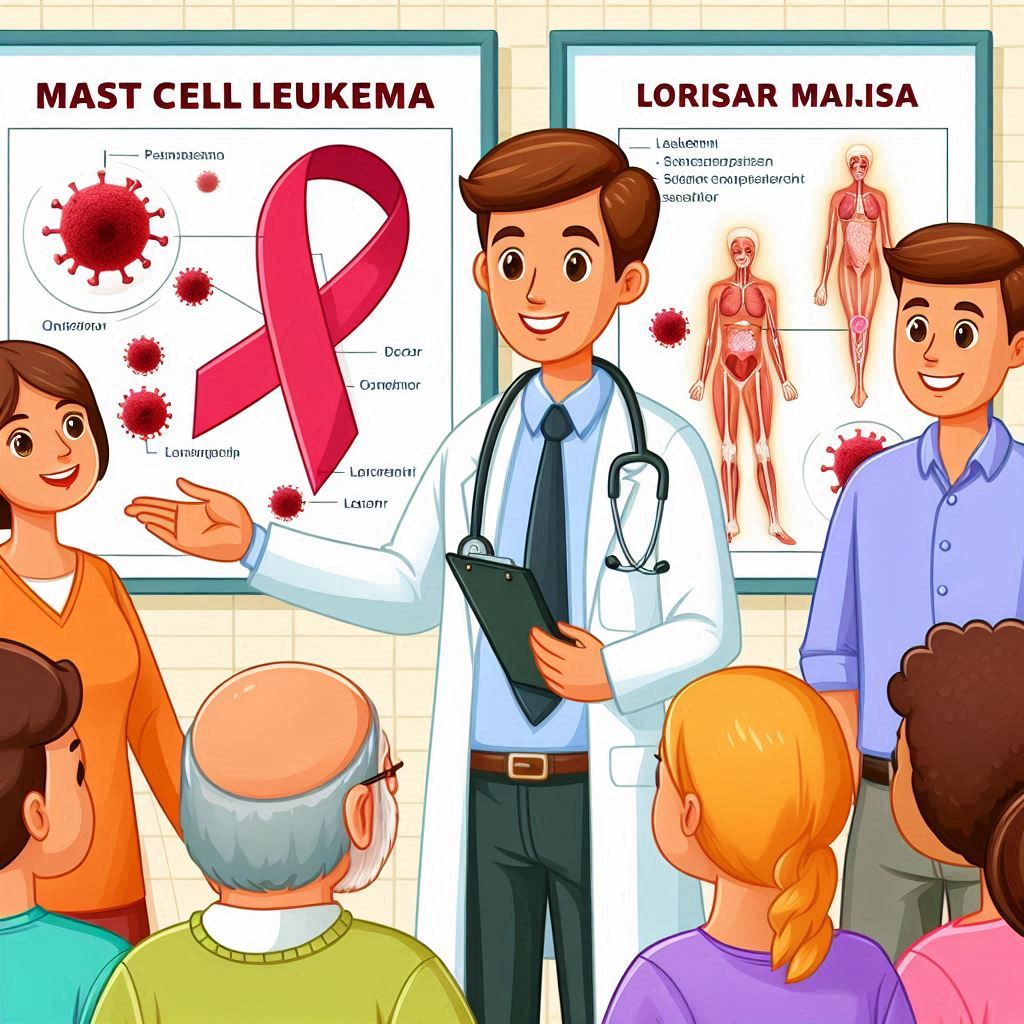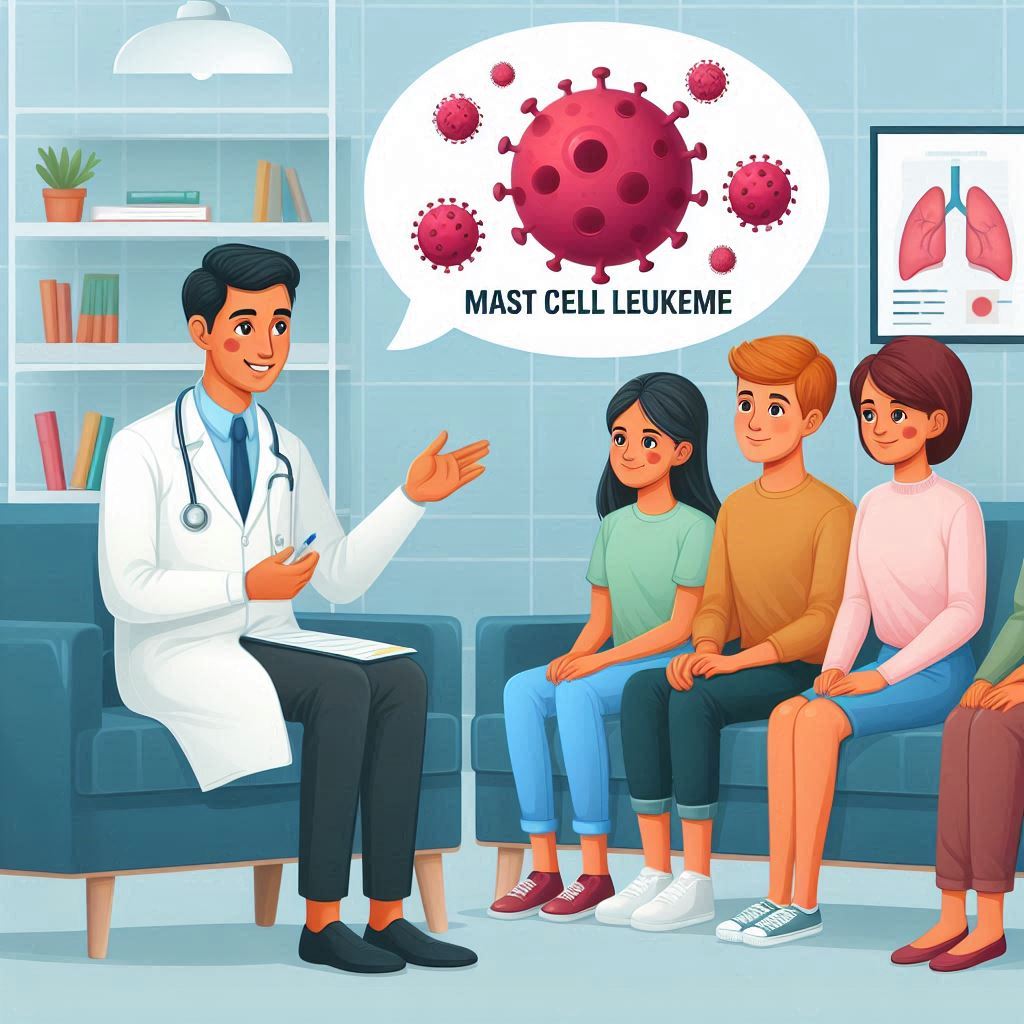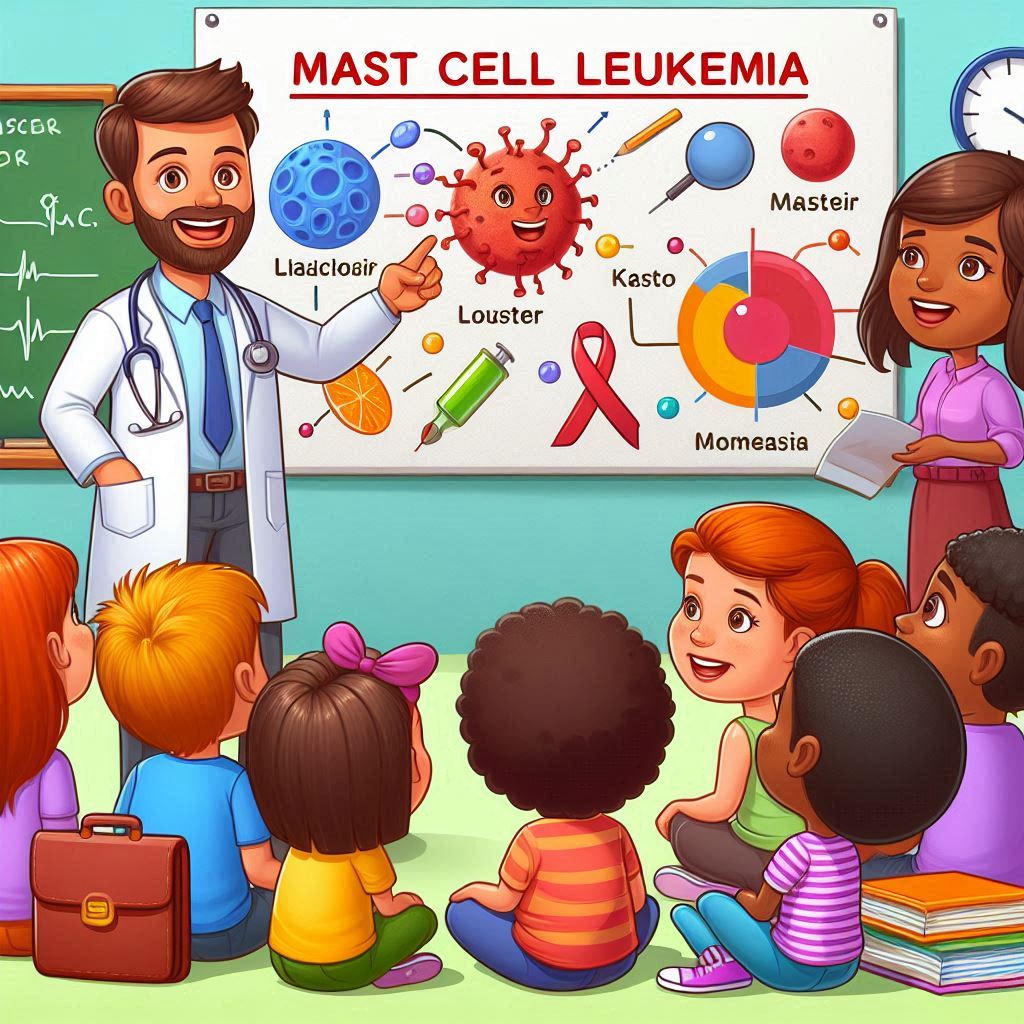Understanding Mast Cell Leukemia Symptoms and Treatment Options

Mast cell leukemia is a rare and aggressive type of leukemia. It accounts for less than 1 percent of all mastocytosis cases, making it one of the rarest forms of leukemia. This condition involves the rapid buildup of abnormal mast cells, which can disrupt normal blood cell production and affect multiple organs. Recognizing its symptoms early can make a significant difference in managing the disease. If you notice unusual fatigue, persistent fever, or unexplained weight loss, consult a healthcare professional promptly. Early diagnosis and treatment improve outcomes and provide a better chance of controlling the disease.
Key Takeaways
Look for early signs of mast cell leukemia like tiredness, fever, and losing weight. Finding it early helps with better treatment.
Talk to a doctor if you see strange symptoms. Quick medical help can make your life much better.
Learn why tests like blood tests and bone marrow checks are important. These tests show if there are unusual mast cells.
Check out treatments like chemotherapy and special medicines. Work with your doctor to pick the best plan for you.
Create a support system. Stay close to family, friends, or join groups to get help and feel supported during this time.
What Is Mast Cell Leukemia?
Definition and Overview
Mast cell leukemia is a rare and aggressive form of systemic mastocytosis. It develops when abnormal mast cells, which are part of your immune system, grow uncontrollably in the bone marrow. These cells can spread to other organs, disrupting their function. Unlike other types of leukemia, mast cell leukemia often presents symptoms similar to mastocytosis, such as skin rashes, fatigue, and organ enlargement. Doctors diagnose this condition when at least 20% of the bone marrow consists of immature mast cells.
Characteristic | Description |
|---|---|
Type | Rare and aggressive subtype of systemic mastocytosis |
Diagnosis | |
Variants | Primary (de novo) or secondary (from prior SM), acute with organ damage or chronic without |
Distinction | Debate on leukemic vs. aleukemic forms based on circulating mast cells |
Symptoms | Similar to mastocytosis rather than acute myeloid leukemia |
Prognosis | Generally grim due to its aggressive nature |
Why Early Recognition Matters
Early recognition of mast cell leukemia can significantly improve your treatment options and outcomes. This disease progresses quickly, often leading to severe symptoms and organ damage. Identifying the condition early allows doctors to begin treatment before complications arise. If you experience unexplained fatigue, weight loss, or persistent fever, seeking medical advice promptly could make a critical difference.
Types of Mast Cell Leukemia
Acute Mast Cell Leukemia
Acute mast cell leukemia (aMCL) is the more aggressive form of the disease. It often leads to organ damage, such as liver dysfunction or bone lesions. Symptoms may include altered blood cell counts, weight loss, and decreased liver function. Over time, this form of leukemia can cause significant complications, making early intervention essential.
Chronic Mast Cell Leukemia
Chronic mast cell leukemia (cMCL) progresses more slowly and does not initially cause organ damage. However, it can still lead to symptoms like fatigue and skin rashes. Over time, chronic mast cell leukemia may evolve into the acute form, increasing the risk of severe complications. Regular monitoring and treatment can help manage the disease and prevent progression.
Symptoms of Mast Cell Leukemia

Recognizing the symptoms of mast cell leukemia can help you seek medical attention early. This condition presents a range of symptoms, from common ones like fatigue to severe complications such as organ enlargement or anaphylaxis.
Common Symptoms
Fatigue and Weakness
Fatigue and weakness are among the most frequently reported symptoms. You may feel unusually tired even after adequate rest. This happens because mast cell leukemia disrupts normal blood cell production, leading to anemia and reduced energy levels.
Fever and Night Sweats
Persistent fever and night sweats often indicate an immune response triggered by the disease. These symptoms can leave you feeling uncomfortable and disrupt your sleep patterns. If you experience these signs without an obvious cause, consult a healthcare provider.
Loss of Appetite and Weight Loss
Loss of appetite and significant weight loss are common in mast cell leukemia. You might notice a decreased desire to eat, which can lead to malnutrition. Losing more than 10% of your body weight without trying is a red flag that requires immediate medical attention.
Symptom | Description |
|---|---|
Fever | Elevated body temperature, often indicating an immune response. |
Weakness | Lack of strength or energy. |
Loss of appetite | Decreased desire to eat. |
Weight loss |
Severe or Rare Symptoms
Organ Enlargement (e.g., liver, spleen)
Mast cell leukemia can cause your liver or spleen to enlarge, a condition known as hepatomegaly or splenomegaly. This may lead to abdominal discomfort or even organ dysfunction. If you feel a sense of fullness or pain in your upper abdomen, it could be a sign of organ enlargement.
Skin Lesions or Rashes
Skin lesions or rashes, often itchy or blistered, are another symptom. These occur due to the accumulation of mast cells in the skin. You might notice these changes as red or raised patches that can cause discomfort.
Anaphylaxis or Severe Allergic Reactions
In rare cases, mast cell leukemia can trigger anaphylaxis, a life-threatening allergic reaction. Symptoms include difficulty breathing, a rapid heartbeat, and swelling. Immediate medical intervention is crucial if you experience these signs.
Other severe symptoms include:
Bone pain, which can indicate disease progression.
Gastrointestinal bleeding, which may appear as blood in vomit or stool.
Lymphadenopathy, or swollen lymph nodes, which can signal systemic involvement.
Note: Severe symptoms often indicate advanced disease stages. Early diagnosis and treatment can help manage these complications effectively.
Diagnosing Mast Cell Leukemia
Medical History and Physical Examination
Diagnosing mast cell leukemia begins with your medical history and a thorough physical examination. Your doctor will ask about symptoms like fatigue, fever, or weight loss. They may also check for signs such as skin rashes, organ enlargement, or swollen lymph nodes. This step helps identify potential red flags and guides further testing.
Diagnostic Tests
To confirm mast cell leukemia, doctors rely on several diagnostic tests. These tests focus on identifying abnormal mast cells and their impact on your body.
Blood Tests
Blood tests are essential for detecting abnormalities in your blood cell counts. A complete blood count (CBC) can reveal anemia, low platelet levels, or an unusually high number of mast cells. These findings often indicate the need for further investigation.
Bone Marrow Biopsy
A bone marrow biopsy is the gold standard for diagnosing mast cell leukemia. During this procedure, a small sample of your bone marrow is extracted and examined under a microscope. Doctors look for at least 20% immature or atypical mast cells, a key diagnostic criterion. This test also helps assess the extent of the disease.
Genetic Testing
Genetic testing plays a crucial role in confirming the diagnosis. Testing for mutations in the KIT gene, commonly associated with mast cell leukemia, provides valuable insights. Techniques like chromosomal analysis and fluorescence in situ hybridization (FISH) are often used. These tests help identify genetic abnormalities that drive the disease.
Diagnostic Criteria
WHO Classification for Mast Cell Leukemia
The World Health Organization (WHO) has established specific criteria for diagnosing mast cell leukemia. To meet these criteria, you must first fulfill the diagnostic requirements for systemic mastocytosis. Additionally, at least 20% of the cells in your bone marrow smear must be immature or atypical mast cells. The disease can be classified as primary (developing on its own) or secondary (arising from a prior systemic mastocytosis). It is further divided into acute forms, which cause organ damage, and chronic forms, which do not. Doctors also distinguish between leukemic and aleukemic forms based on the percentage of circulating mast cells.
Tip: Early and accurate diagnosis is critical for starting treatment promptly and improving outcomes.
Treatment Options for Mast Cell Leukemia

Chemotherapy
Commonly Used Drugs
Chemotherapy plays a key role in treating mast cell leukemia. It works by targeting and destroying rapidly dividing cells, including abnormal mast cells. Several drugs and regimens are commonly used in treatment:
Drug/Regimen | Description |
|---|---|
Intron A (interferon-alpha) | A medication that may help control the disease. |
Mavenclad (cladribine) | Another effective option for managing symptoms. |
FLAG | Combines fludarabine, cytarabine, and G-CSF to target leukemia. |
CLAG | Includes cladribine, cytarabine, and G-CSF for aggressive cases. |
Hydroxyurea | Reduces symptoms and helps manage the disease. |
Your doctor will choose a specific drug or regimen based on your condition and overall health.
Managing Side Effects
Chemotherapy can cause side effects like nausea, fatigue, and hair loss. You can manage these effects by staying hydrated, eating small, nutritious meals, and resting when needed. Medications prescribed by your doctor can also help reduce nausea and other symptoms. Open communication with your healthcare team ensures better management of side effects.
Targeted Therapy
Tyrosine Kinase Inhibitors
Tyrosine kinase inhibitors (TKIs) are a promising option for mast cell leukemia. These drugs block enzymes that abnormal mast cells need to grow and divide. However, their effectiveness may be limited if gene mutations are present in the mast cells. Your doctor may recommend genetic testing to determine if TKIs are suitable for you.
Monoclonal Antibodies
Monoclonal antibodies are another targeted therapy option. These lab-made proteins attach to specific markers on mast cells, helping your immune system destroy them. This approach can reduce symptoms and slow disease progression. Discuss with your doctor if this therapy aligns with your treatment goals.
Stem Cell Transplant
When It Is Recommended
Stem cell transplantation is often recommended for advanced cases of mast cell leukemia. This procedure involves high-dose chemotherapy or radiation to eliminate existing blood cells and stem cells. Afterward, healthy stem cells from a donor are infused into your body to rebuild your blood and immune system.
Risks and Benefits
While stem cell transplants offer the potential for long-term remission, they come with risks. These include infections, graft-versus-host disease, and organ damage. However, the benefits can outweigh the risks for eligible patients. Your doctor will evaluate your overall health and disease stage before recommending this option.
Supportive Care
Symptom Management
Supportive care focuses on improving your quality of life while managing the symptoms of mast cell leukemia. This approach addresses both physical and emotional challenges. Symptom management often involves medications to control pain, nausea, or itching caused by the disease. For example, antihistamines can reduce allergic reactions, while corticosteroids may help with inflammation.
You can also benefit from lifestyle adjustments. Staying hydrated and maintaining a consistent sleep schedule can help combat fatigue. If you experience bone pain, physical therapy or gentle exercises may provide relief. Always discuss these options with your healthcare provider to ensure they align with your treatment plan.
Tip: Keep a symptom journal. Tracking your symptoms can help your doctor adjust treatments more effectively.
Nutritional and Emotional Support
Proper nutrition plays a vital role in managing mast cell leukemia. A balanced diet rich in fruits, vegetables, lean proteins, and whole grains can strengthen your body and support recovery. If you struggle with appetite loss, try eating smaller, nutrient-dense meals throughout the day. Consulting a dietitian can provide personalized guidance.
Emotional support is equally important. Living with mast cell leukemia can feel overwhelming, but you don’t have to face it alone. Talking to a counselor or joining a support group can help you process your emotions and connect with others who understand your journey. Building a strong support network of family and friends can also make a significant difference.
Note: Emotional well-being directly impacts physical health. Prioritize activities that bring you joy and relaxation.
Prognosis and Living with Mast Cell Leukemia
Factors Influencing Prognosis
Stage at Diagnosis
The stage at which mast cell leukemia is diagnosed plays a critical role in determining your prognosis. Early detection, especially in chronic forms without organ damage, often leads to better outcomes. Chronic mast cell leukemia generally has a longer survival rate compared to acute forms. For instance, patients with chronic mast cell leukemia and no organ damage tend to have a better prognosis. However, the presence of genetic mutations like SRSF2, ASXL1, or RUNX1 can worsen outcomes.
Condition | Average Survival Rate | Notes |
|---|---|---|
Chronic MCL (no organ damage) | Better prognosis | Generally associated with longer survival |
MCL with genetic mutations | Worse outcomes | Linked to shorter survival rates |
Average survival (with treatment) | Improvement noted with new treatments | |
Average survival (without treatment) | 6 months | Indicates poor prognosis without treatment |
Response to Treatment
Your response to treatment significantly impacts your prognosis. Effective therapies, such as chemotherapy or targeted treatments, can improve survival rates and quality of life. Patients who respond well to treatment often experience longer remission periods. However, those with aggressive forms or genetic mutations may face challenges in achieving positive outcomes. Regular monitoring and adjustments to your treatment plan can help optimize results.
Factor | Prognosis Impact |
|---|---|
Better prognosis | |
Genetic mutations (SRSF2, ASXL1, RUNX1) | Worse outcomes |
Coping with Mast Cell Leukemia
Practical Coping Strategies
Living with mast cell leukemia requires practical strategies to manage daily challenges. Maintaining a symptom journal can help you track changes and communicate effectively with your healthcare team. Adopting a balanced diet rich in nutrients supports your body during treatment. Gentle exercises, such as walking or yoga, can improve your energy levels and reduce stress. Prioritize rest and avoid overexertion to conserve energy.
Tip: Break tasks into smaller steps to make them more manageable. This approach helps you maintain productivity without feeling overwhelmed.
Building a Support Network
A strong support network can make a significant difference in your journey. Surround yourself with family and friends who can provide emotional and practical assistance. Joining a support group allows you to connect with others facing similar challenges. Sharing experiences and advice can help you feel less isolated. Professional counseling can also provide tools to cope with the emotional impact of the disease.
Note: You are not alone in this journey. Many resources and communities are available to support you.
Recognizing the symptoms of mast cell leukemia early can make a significant difference in your treatment journey. Common signs include altered blood cell counts, weight loss, and bone lesions. Diagnostic procedures like blood tests and bone marrow biopsies confirm the presence of abnormal mast cells. Early diagnosis allows for timely intervention, improving your chances of managing the disease effectively.
Treatment options continue to advance, offering hope to patients. Targeted therapies such as Rydapt and Ayvakit show promise, while chemotherapy and corticosteroids help control symptoms. For eligible patients, stem cell transplantation may provide long-term remission. These treatments, combined with supportive care, can enhance your quality of life.
Healthcare professionals and support groups play a vital role in your journey. Specialists can address your mental health needs, while organizations like the Leukemia and Lymphoma Society offer valuable resources. Connecting with others through support groups fosters a sense of community and shared understanding.
Tip: Take proactive steps by consulting your doctor and exploring available support networks. You are not alone in this journey.
FAQ
What makes mast cell leukemia different from other types of leukemia?
Mast cell leukemia is rare and aggressive. It involves the rapid buildup of abnormal mast cells in your bone marrow and organs. Unlike other leukemias, it often presents with symptoms like skin rashes, organ enlargement, and severe allergic reactions.
Can mast cell leukemia be cured?
Currently, no definitive cure exists for mast cell leukemia. However, treatments like chemotherapy, targeted therapy, and stem cell transplants can help manage the disease. Early diagnosis and personalized treatment plans improve your chances of achieving remission.
How is mast cell leukemia diagnosed?
Doctors use blood tests, bone marrow biopsies, and genetic testing to diagnose mast cell leukemia. These tests identify abnormal mast cells and genetic mutations. Meeting specific criteria, such as the presence of 20% immature mast cells in your bone marrow, confirms the diagnosis.
Are there lifestyle changes that can help manage symptoms?
Yes, lifestyle changes can support your treatment. Eating a balanced diet, staying hydrated, and getting enough rest can improve your energy levels. Gentle exercises like yoga may help reduce stress. Keeping a symptom journal can also help your doctor adjust treatments effectively.
What should you do if you suspect mast cell leukemia?
If you notice symptoms like persistent fatigue, unexplained weight loss, or skin rashes, consult a healthcare provider immediately. Early diagnosis allows for timely treatment, which can improve your quality of life and overall prognosis.
Tip: Don’t ignore unusual symptoms. Seeking medical advice early can make a significant difference.
---
ℹ️ Explore more: Read our Comprehensive Guide to All Known Cancer Types for symptoms, causes, and treatments.
See Also
A Simple Guide to B-Cell Prolymphocytic Leukemia
Exploring Hairy Cell Leukemia: Symptoms and Overview
Symptoms and Causes of Chronic Myelogenous Leukemia Explained
